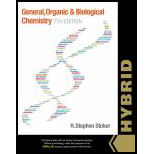
(a)
Interpretation:
The boiling point of solution containing
Concept Introduction:
Boiling point is the temperature at which liquid turns into a gas. Example: boiling point of water is
Where,
Boiling point elevation
Where,
M is the molality of the solution
i is van’t Hoff factor
Note:
The boiling point of one kilogram of water will be increase by
(a)
Explanation of Solution
Given that
The addition of one mole of solute particles dissolved in one-kilogram of water will raise the boiling point of solution by
Therefore, the number of moles per kilogram in the solution has to be calculated and have to multiply by
One mole of dissolved sucrose will forms one mole of dissolved particles.
Boiling point increase can be calculated as follows:
Boiling point calculation:
(b)
Interpretation:
The boiling point of solution containing
Concept Introduction:
Boiling point is the temperature at which liquid turns into a gas. Example: boiling point of water is
Where,
Boiling point elevation
Where,
M is the molality of the solution
i is van’t Hoff factor
Note:
The boiling point of one kilogram of water will be increase by
(b)
Explanation of Solution
Given that
The addition of one mole of solute particles dissolved in one-kilogram of water will raise the boiling point of solution by
Therefore, the number of moles per kilogram in the solution has to be calculated and have to multiply by
One mole of dissolved sucrose will forms one mole of dissolved particles.
Boiling point increase can be calculated as follows:
Boiling point calculation:
(c)
Interpretation:
The boiling point of solution containing
Concept Introduction:
Boiling point is the temperature at which liquid turns into a gas. Example: boiling point of water is
Where,
Boiling point elevation
Where,
M is the molality of the solution
i is van’t Hoff factor
Note:
The boiling point of one kilogram of water will be increase by
(c)
Explanation of Solution
Given that
The addition of one mole of solute particles dissolved in one-kilogram of water will raise the boiling point of solution by
Therefore, the number of moles per kilogram in the solution has to be calculated and have to multiply by
One mole of dissolved sucrose will forms one mole of dissolved particles.
Boiling point increase can be calculated as follows:
Boiling point calculation:
(d)
Interpretation:
The boiling point of solution containing
Concept Introduction:
Boiling point is the temperature at which liquid turns into a gas. Example: boiling point of water is
Where,
Boiling point elevation
Where,
M is the molality of the solution
i is van’t Hoff factor
Note:
The boiling point of one kilogram of water will be increase by
(d)
Explanation of Solution
Given that
The addition of one mole of solute particles dissolved in one-kilogram of water will raise the boiling point of solution by
Therefore, the number of moles per kilogram in the solution has to be calculated and have to multiply by
One mole of dissolved sucrose will forms one mole of dissolved particles.
Boiling point increase can be calculated as follows:
Boiling point calculation:
Want to see more full solutions like this?
Chapter 8 Solutions
General, Organic, And Biological Chemistry, Hybrid (with Owlv2 Quick Prep For General Chemistry Printed Access Card)
- In your own words, explain why (a) seawater has a lower freezing point than fresh water. (b) salt is added to the ice in an ice cream maker to freeze the ice cream faster.arrow_forwardEqual numbers of moles of two soluble, substances, substance A and substance B, are placed into separate 1.0-L samples of water. a The water samples are cooled. Sample A freezes at 0.50C, and Sample B freezes at l.00C. Explain how the solutions can have different freezing points. b You pour 500 mL of the solution containing substance B into a different beaker. How would the freezing point of this 500-mL portion of solution B compare to the freezing point of the 1.0-L sample of solution A? c Calculate the molality of the solutions of A and B. Assume that i = 1 for substance A. d If you were to add an additional 1.0 kg of water to solution B, what would be the new freezing point of the solution? Try to write an answer to this question without using a mathematical formula. e What concentration (molality) of substances A and B would result in both solutions having a freezing point of 0.25C? f Compare the boiling points, vapor pressure, and osmotic pressure of the original solutions of A and B. Dont perform the calculations; just state which is the greater in each ease.arrow_forwardIn your own words, explain (a) why seawater has a lower freezing point than fresh water. (b) why one often obtains a grainy product when making fudge (a supersaturated sugar solution). (c) why the concentrations of solutions used for intravenous feeding must be controlled carefully. (d) why fish in a lake (and fishermen) seek deep, shaded places during summer afternoons. (e) why champagne fizzes in a glass.arrow_forward
 World of Chemistry, 3rd editionChemistryISBN:9781133109655Author:Steven S. Zumdahl, Susan L. Zumdahl, Donald J. DeCostePublisher:Brooks / Cole / Cengage Learning
World of Chemistry, 3rd editionChemistryISBN:9781133109655Author:Steven S. Zumdahl, Susan L. Zumdahl, Donald J. DeCostePublisher:Brooks / Cole / Cengage Learning General, Organic, and Biological ChemistryChemistryISBN:9781285853918Author:H. Stephen StokerPublisher:Cengage Learning
General, Organic, and Biological ChemistryChemistryISBN:9781285853918Author:H. Stephen StokerPublisher:Cengage Learning- Chemistry: Matter and ChangeChemistryISBN:9780078746376Author:Dinah Zike, Laurel Dingrando, Nicholas Hainen, Cheryl WistromPublisher:Glencoe/McGraw-Hill School Pub Co
 Chemistry: The Molecular ScienceChemistryISBN:9781285199047Author:John W. Moore, Conrad L. StanitskiPublisher:Cengage Learning
Chemistry: The Molecular ScienceChemistryISBN:9781285199047Author:John W. Moore, Conrad L. StanitskiPublisher:Cengage Learning Chemistry: Principles and PracticeChemistryISBN:9780534420123Author:Daniel L. Reger, Scott R. Goode, David W. Ball, Edward MercerPublisher:Cengage Learning
Chemistry: Principles and PracticeChemistryISBN:9780534420123Author:Daniel L. Reger, Scott R. Goode, David W. Ball, Edward MercerPublisher:Cengage Learning





